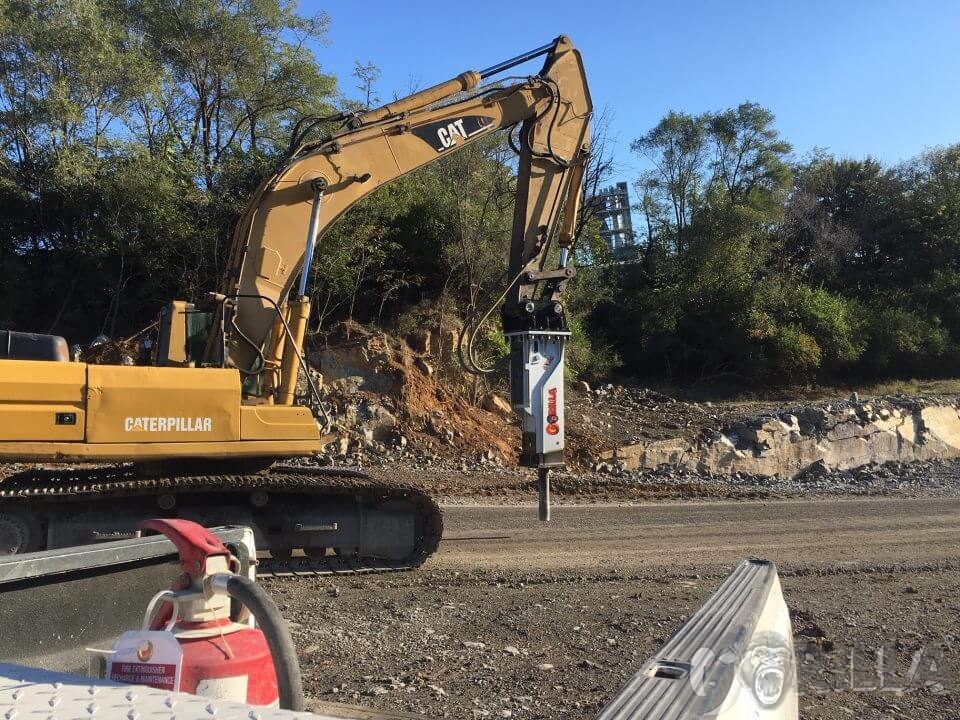How Hydraulic Hammer & Breakers Are Being Used In Concrete Recycling Industry
April 23, 2018Excavators Provide Varied Options For Demolition & Construction Contractors & For C&D Recyclers
April 23, 2018Recycling Today,
March, 2005 by Deanne Toto
The demolition scrap stream remains an important source of ferrous and nonferrous scrap, with grades ranging from structural beams to copper wire being pulled from buildings during the demolition process.
As controlled demolition–the technique of using high-reach hydraulic handlers or skid-steer loaders fitted with a variety of attachments to carefully deconstruct a building–gains popularity in North America, so does the importance of having the appropriate battery of attachments to perform a variety of tasks common to many demolition sites.
When coupled with a hydraulic excavator, or even compact excavators and skid steers, the right attachments can increase a demolition contractor’s productivity on site and make the recycling of those materials that much easier.
AIMING HIGH. “I think the high-reach systems are a safer and more economical alternative,” Kevin Loumas of Atlas Copco, which is based in West Springfield, Mass., says. “With the high-reach machines and the attachments that are available today, they lend themselves to the needs of recycling and debris processing. I think it cuts back on the labor necessary to do a job than a drop ball used years ago,” he adds.
Poul Rosengaard, senior application engineer for Caterpillar Work Tools, Peoria, Ill, also finds the controlled approach preferable for safety reasons. “The wrecking ball is a dangerous tool and very hard to control,” he says.
Tom Witt, director of sales for Breaker Technology Inc. (BTI), Thornbury, Ont., agrees that demolition attachments mounted on long-reach excavators provide advantages. “With the long-reach excavator, you have better ability to control the demolition, which is especially critical in urban areas.”
The effectiveness of the excavators depends in large part on the attachments.
GRASPING THE SITUATION. “Today, demolition contractors have a variety of attachment choices,” Michele Carline of Tramac Corp., Parsippany, N.J., says. “These attachments are high-production units that are mounted on excavators, loader backhoes, skid-steer loaders and mini-excavators.”
In addition to demolishing structures, demolition contractors face a variety of recycling-related tasks, including the primary sizing and separation of material. This necessitates a number of tools, though just how many depends on the size and nature of the job and the time constraints a contractor faces, Cat’s Rosengaard says.
Carline says that the most popular attachments include hydraulic breakers, demolition processors, shears and demolition grapples. “Each attachment has a unique function that helps the contractor increase production,” she adds.
Kevin Bakke, chairman of Genesis Attachments, Superior, Wis., says the versatility of grapples on a demolition site is often understated. “Our GSD (severe-duty) contractor’s grapple is built to do a lot of actual demolition in terms of ripping and tearing a structure apart,” he says. “It can act almost as a shear to an extent if the steel is in the realm of the excavator’s break-out force.” The grapple then can be used to pick and sort through the resulting rubble.
“Grapples have been the main choice for material handling tasks among recyclers for many years,” Carline says. Their dexterity and ability to handle large volumes of bulky, inconsistently sized material gives them an advantage over standard buckets on the demolition site.
“There is normally quite a bit of material sorting done of C&D, and the sorting requirement is almost certainly increasing in Importance,” Rosengaard says. “The mechanical grapple (contractor’s grapple) is much better suited for the sorting task than a bucket.”
While grapples are just one of the tools available to demolition contractors, smaller contractors may not be able to afford a variety of dedicated attachments. Such contractors may instead opt for multi-processors or universal processors to perform the duties of pulverizers and shears, for instance. These tools feature a primary tool with three or four interchangeable sets of jaws, allowing the base attachment to go from a crusher to a pulverizer to a shear, depending on the particular task at hand.
BREAKING IT DOWN. BTI’s Witt says multi-tools give smaller contractors much more versatility while also allowing them to keep operational costs down.
“If you are a smaller, independent contractor where the versatility of your equipment is extremely important and you want to tackle a job, then the multi-processor offers you a lot of options,” Witt says.
Not only can a demolition contractor save money by purchasing fewer attachments, he can also scale back his crew. “You can eliminate one machine and one man off the job,” Witt says.
Carline says Tramac’s DA Series processor “allows you to demolish a structure and to recycle the material as required by the job.” The attachment features “easy-change” jaws that allow it to perform multiple functions.
Atlas Copco offers a multi-processor it calls the Combi Cutter. “A Combi Cutter is an attachment that we supply that allows you to switch between a cutting jaw for steel and a pulverizing jaw for smashing bricks or mortar,” Loumis says. “These are more versatile because you can do two jobs with one attachment.”
Genesis manufactures a similar processor that it calls the DemoPro. However, it does not require a complete jaw change, which helps contractors to save time on the job site, Bakke says.
“Our tool is designed with a multipurpose jaw that requires no change-out,” he says. “At most, they can simply bolt in different concrete pulverizer points, or they can bolt in a steel piercing tip if they have a steady diet of structural steel to process.” Bakke says these adjustments can be made in about 10 minutes.
While multi-processors offer versatility and affordability, some contractors may prefer to go with dedicated tools, which typically offer higher efficiency.
TEARING IT UP. Witt says he sees more hydraulic pulverizers being used in secondary demolition. “They can do so many things with them and they can take a lot bigger concrete than they used to with the manual-type crushers.”
He says hydraulic pulverizers can be mounted on smaller excavators, such as those in the 25-to-30-ton range, though they can do the work of a mechanical tool mounted to a 100-ton excavator.
The hydraulic tool’s extra power comes from its piston, which is powered by the hydraulic circuitry of the excavator. Mechanical tools, however, use the bucket’s cylinder to generate force.
Atlas Copco’s Loumas also finds hydraulics advantageous when working with concrete, enabling a contractor to process more in a given time frame, while reducing carrier wear.
“It is less destructive to the carrier. On some mechanical units, you are physically picking some of these things up and dropping them on the debris,” Loumas says.
However, if the structure contains a lot of structural steel, a shear is a natural choice. Demolitio
“If there is a lot of steel, the perfect solution is a steel cutting shear with 360-degree rotation. It is almost vital to have that rotation so you can work at every angle,” Bakke says. “A rotating shear sized to the job is priceless.” Thanks to the increase in the use of controlled demolition techniques, it appears hydraulic attachments will grow in importance in the years to come.
INSIDE JOB
Demolition contractors use compact excavators and skid steers outfitted with a variety of attachments to perform “infrastructure” demolition, or the removal of plumbing and heating and electrical systems within a building.
“In controlled demolition the contractor will normally remove any material with salvage value, such as wires, conduits, pipes and electrical equipment, using small shears and grapples on skid-steer loaders or mini- or standard-size excavators,” Poul Rosengaard, senior application engineer for Caterpillar Work Tools, Peoria, III., says.
“Due to the compact size, low weight and speed of skid-steer loaders, these machines are becoming much more popular in demolition applications,” Rosengaard continues. “Also, with the ever-increasing versatility and great selection of work tools available for the skid-steer loader, they are widely used in selective demolition jobs, like refurbishment of residential and office buildings. The use of skid=steer loader machine and the appropriate work tools are often needed when working within the city limits.”
Kevin Loumas at West Springfield, Mass.-based Atlas Copco, says the use of these carriers, equipped with either hydraulic hammers, grapples, shears or pulverizers, has increased greatly during the last eight years.
“They have a variety of attachments, plus they are light and they can work in confined areas, especially the compact excavators,” Tom Witt, director of sales for Breaker Technology Inc., Thornbury, Ont., says.
While he says compact excavators are nice because they can sit in one spot and reach around to demolish the surrounding areas, a skid steer equipped with a bucket is ideal for picking up material and loading it out.
The two carriers, equipped with various attachments and used in combination, could provide contractors with an expedient solution for interior and infrastructure demolition tasks.
PERFECT UNION
Quick couplers are helping to increase versatility on demolition job sites by allowing excavator operators to quickly change attachments.
Kevin Bakke, chairman of Genesis Attachments, Superior, Wis., says more and more contractors are making use of quick couplers.
Operators of excavators equipped with hydraulic quick-couplers don’t even have to leave the cab to move from a pulverizer to a shear. “He just flips a switch, unlocks one attachment and goes for the other,” Bakke says. “That can be as quick as a one-minute change-out.”
Mechanical couplers require that the excavator operator leave the cab to remove a few pins from the current attachment and insert them in the new attachment, but the job can still be performed in five to 10 minutes.
This article originally appeared under the title “Four Arsenal” in Construction & Demolition Recycling magazine. The author is a managing editor in the Recycling Today Media Group and can be reached at dtoto@gie.net.
COPYRIGHT 2005 G.I.E. Media, Inc.
COPYRIGHT 2005 Gale Group



